Last updated: August 4, 2023
Article
Two American Entrepreneurs: Madam C.J. Walker and J.C. Penney (Teaching with Historic Places)
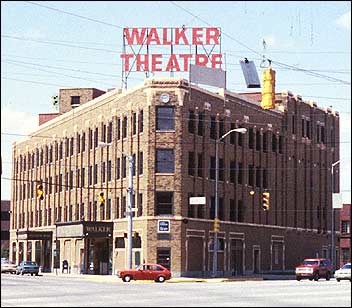
(Indiana Division of Historic Preservation and Archaeology)
This lesson is part of the National Park Service’s Teaching with Historic Places (TwHP) program.
At a busy intersection in the bustling city of Indianapolis, Indiana, stands the imposing four-story brick structure known as the Walker Building. Buff-colored terra cotta is used for decorative details, and each doorway is embellished with brightly colored African masks. Completed in 1927, this magnificent building marks the climax of the career of Madam C.J. Walker, one of America's most successful African-American businesswoman of the early 20th century. Much of the building served as the headquarters of the Madam C. J. Walker Manufacturing Company, a business which employed some 3,000 African-American women and men to manufacture and sell hair products and cosmetics. The Walker Building, planned by Madam Walker herself but constructed after her death, was designed to serve not only as the headquarters for her business, but as a social and cultural center for African Americans in Indianapolis. Today, it houses the Madam Walker Theatre Center and various commercial businesses.
A thousand miles to the west, in the small town of Kemmerer in western Wyoming, stands a small building that represents the early days of another successful career. This building housed the Golden Rule Store, a dry goods business that grew into the J. C. Penney Company, the first nationwide chain of department stores in the country. Built about 1897, the two-story stone building features a cast iron storefront decorated with rosettes and scrollwork and an elaborate metal cornice. When James Cash Penney moved his dry goods business here in 1904, the building also housed a saloon, offices, and apartments. In a 25-by-140 foot section of the first floor, Penney developed and refined the merchandising ideas that led to the growth of his successful chain of stores.
These two historic buildings--one large and imposing, the other modest--provide insight into the characters of two of America's most famous businesspeople. Both Walker and Penney overcame great odds, and both combined a desire to serve others with great financial success.
About This Lesson
This lesson is based on the National Historic Landmark files, "Madam C.J. Walker Building" (with photographs) and "J.C. Penney Historic District" (with photographs), as well as other sources related to Madam Walker and J.C. Penney. It was written by Rita Koman, education consultant. The lesson was edited by the Teaching with Historic Places staff. TwHP is sponsored, in part, by the Cultural Resources Training Initiative and Parks as Classrooms programs of the National Park Service. This lesson is one in a series that brings the important stories of historic places into the classrooms across the country.
Where it fits into the curriculum
Topics: The lesson could be used in American History courses in units on early 20thcentury business development. It provides an interesting contrast to the typical textbook coverage, which tends to emphasize a few robber barons, while giving little information on the success stories of other exceptional people who moved from rags to riches. The lesson also could be used to enhance the study of African American history or women's history.
Time period: Early 20th century
United States History Standards for Grades 5-12
Two American Entrepreneurs: Madam C.J. Walker and J.C. Penney
relates to the following National Standards for History:
Era 6: The Development of the Industrial United States (1870-1900)
-
Standard 1A- The student understands the connections among industrialization, the advent of the modern corporation, and material well-being.
-
Standard 2B- The student understands "scientific racism", race relations, and the struggle for equal rights.
-
Standard 2C- The student understands how new cultural movements at different social levels affected American life.Era 7: The Emergence of Modern America (1890-1930)
-
Standard 3B- The student understands how a modern capitalist economy emerged in the 1920s.
-
Standard 3C- The student understands how new cultural movements reflected and changed American society.
Curriculum Standards for Social Studies
(National Council for the Social Studies)
American Entrepreneurs: Madam C.J. Walker and J.C. Penney relates to the following Social Studies Standards:
Theme III: People, Places, and Environment
-
Standard G- The student describes how people create places that reflect cultural values and ideals as they build neighborhoods, parks, shopping centers, and the like.Theme IV: Individual Development and Identity
-
Standard D - The student relates such factors as physical endowment and capabilities, learning, motivation, personality, perception, and behavior to individual development.Theme VII: Production, Distribution, and Consumption
-
Standard B - The student shows through specific examples how science and technology have changed people's perceptions of the social and natural world, such as in their relationships to the land, animal life, family life, and economic needs, wants and security.
-
Standard E - The student describes the role of specialization and exchange in the economic process.
-
Standard F - The student explains and illustrates how values and beliefs influence different economic decisions.
Objectives for students
1) To identify the attributes that helped Walker and Penney to succeed as entrepreneurs.
2) To compare and contrast Walker and Penney for similarities and differences in backgrounds and business methods.
3) To consider the role advertising played in the business success of Walker and Penney.
4) To analyze the factors necessary for founding a successful business today and compare them with those needed in Walker's and Penney's day.
5) To investigate whether businesses in their community were established by entrepreneurs with characteristics like those of Walker and Penney.
Materials for students
The materials listed below either can be used directly on the computer or can be printed out, photocopied, and distributed to students. The maps and images appear twice: in a low-resolution version with associated questions and alone in a larger, high-resolution version.
1) two maps of cities associated with Walker and Penney;
2) three readings about the lives of Madam Walker and J.C. Penney;
3) two advertisements for Madam Walker beauty preparations and Penney's Golden Rule Store;
4) five photographs and a drawing of Madam Walker, Walker Manufacturing buildings, and J.C. Penney's early stores.
Visiting the sites
The Walker Building is located at the intersection of West Street and Indiana Avenue in downtown Indianapolis. The address is 6l7 Indiana Avenue, Indianapolis, Indiana 46202. Today the building houses commercial businesses as well as the Madame Walker Theatre Center, which provides arts and cultural programs and education for children and adults. The Center also includes a small museum with Walker memorabilia and is host to the annual Madame Walker Spirit Awards for Entrepreneurs. The former Golden Rule Store is located at 803 South Main Street on the eastern edge of the business district in Kemmerer, Wyoming. It is part of the J.C. Penney Historic District, which also includes Penney's first house. Today, the restored six-room house is a museum operated by the J.C. Penney Foundation. It is open seven days a week from Memorial Day through Labor Day. The house is open for tours by appointment at other times. For more information, contact Kemmerer's J.C. Penney Store at 722 J.C. Penney Drive, Kemmerer, Wyoming 83101. The store has been in operation at this location since 1929.
Getting Started
Inquiry Question
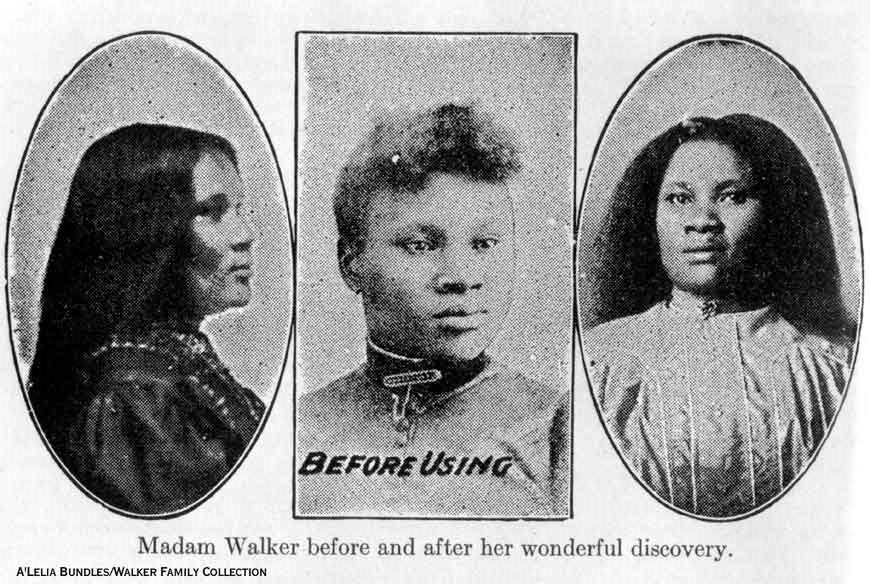
What might her wonderful discovery be?
Setting the Stage
The workplaces described in this lesson reveal a good deal about the philosophies and interests of two successful early 20th-century businesspeople who stuck by their principles as they pursued their dreams: Madam C.J. Walker and James Cash Penney. Madam C.J. Walker (1867-1919) developed, manufactured, and sold formulas for hair care and other beauty products for African-American women. She began selling her homemade products door-to-door in 1905 in Denver, Colorado. She eventually distributed them nationwide (and even internationally) through mail-order and with the help of trained door-to-door sales representatives known as "Walker Agents." The business ultimately helped thousands of African-American women achieve financial success. In 1910, she headquartered her operation in Indianapolis, Indiana, a city with a thriving African-American community.
James Cash Penney (1875-1971) believed that working people in isolated regions in the West deserved to have dry goods stores nearby that would offer quality products at reasonable prices. He opened his first store, called the Golden Rule, in Kemmerer, Wyoming, in 1902. Soon he began establishing stores in other towns in Wyoming and then throughout the United States. He based his business on the principle, "Do unto others as you would have them do unto you." This was unusual at a time when consumers often were faced with poor quality merchandise, fraudulent claims about quality, and deceptive pricing practices. Crucial to Penney's success were his associates (as he referred to his employees). He even helped many of his store managers become part owners of new stores. In 1913, the successful business was incorporated as the J.C. Penney Company. Today, J.C. Penney Company operates more than 1,100 stores in all 50 states.
Walker's and Penney's desire to provide people with high quality services and affordable merchandise may well have been based on personal experiences. Both grew up in small towns--Walker in truly poor surroundings in Louisiana and Mississippi, Penney in modest financial circumstances in Missouri. Both had to become self-reliant at very early ages and learned that hard work alone would not fulfill their aspirations. They both knew that their success depended on meeting the needs and desires of their customers, men and women much like themselves. They believed that part of their mission was to help others to succeed as they had done. Neither Walker nor Penney ever eased up on the prodigious amounts of work they performed. Both were still on the job when they died: Walker at the relatively early age of 51, and Penney at 95.
Locating the Site
Map 1: The United States.
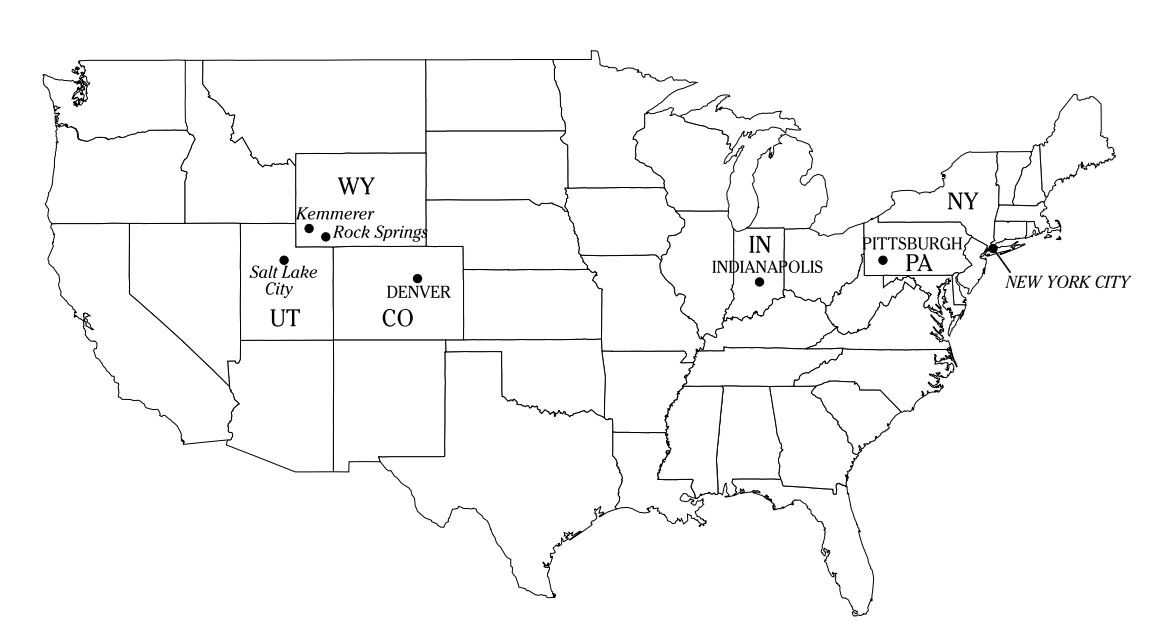
The cities marked in all capital letters indicate places where Madam Walker established or headquartered her business. The cities in italics indicate places where J.C. Penney opened his early stores or headquartered his business.
Questions for Map 1
1. Compare the locations of the cities marked on the map. What do they have in common? How do they differ? Do the various places each person established businesses show any pattern?
2. Both Madam Walker and J.C. Penney established a base of operation in New York City and ultimately made it their permanent home. Why might this have been the case?
Locating the Site
Map 2: Indianapolis, Indiana.
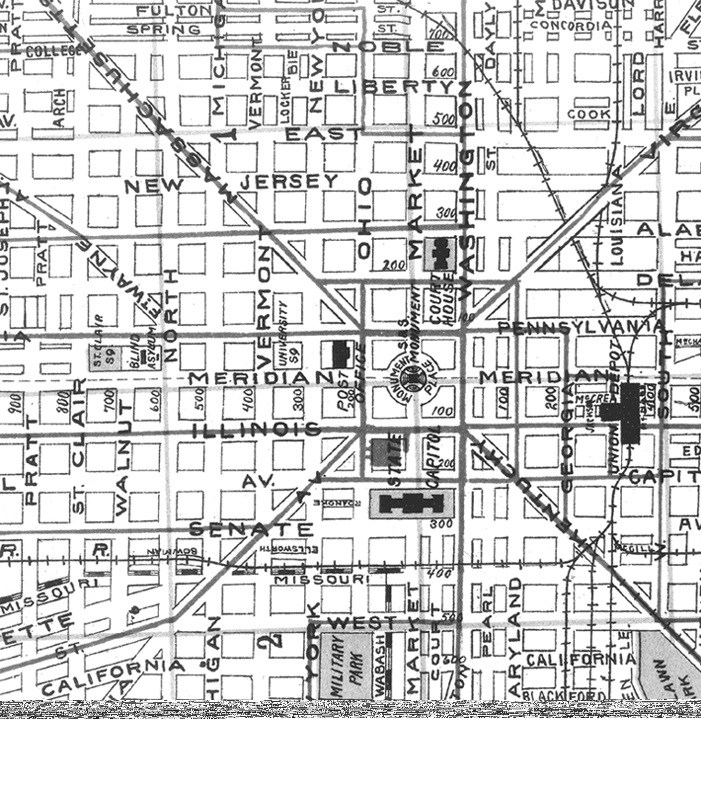
Madam Walker was so impressed during a visit to Indianapolis in 1910 that she decided to make it her national headquarters. The city was served by eight major railway systems and was home to a substantial African-American community. She built a factory there that employed local African-American men and women. Before her death, Madam Walker planned an ambitious new building for her headquarters. Completed by her daughter in 1927, the Walker Building housed her company as well as other businesses.
Questions for Map 2
1. Why would the railway system in Indianapolis have been important to Madam Walker's business?
2. Locate Monument Circle, the historic center of the city of Indianapolis. Find North, South, East, and West streets, which were the original boundaries of the city.
3. Locate and circle the area around the intersection of Indiana Avenue and West Street, which was the heart of Indianapolis's African-American community. It was lined with cafes, offices, and other thriving businesses.
4. Find the location of Madam Walker's original manufacturing building (built in 1910) on the east side of West Street between North and Walnut streets. Now find the present Walker Building (built in 1927), across the street at the northwest corner of Indiana Avenue and West Street. Why would Walker have decided to establish her business and subsequently plan a commercial and social building in this area?
Determining the Facts
Reading 1: Meet Madam C.J. Walker
I had to make my own living and my own opportunity! But I made it! Don't sit down and wait for the opportunities to come. Get up and make them!1
Born as Sarah Breedlove in December 1867, in Delta, Louisiana, Madame Walker was the third child and second daughter of Minerva and Owen Breedlove. Former slaves, the Breedloves worked as sharecroppers on a cotton plantation and lived in a one-room cabin. By the time she was five, Sarah had learned to carry water to field hands, drop cotton seed into plowed furrows, and, for a dollar a week, wash white people's clothes with strong lye soap, wooden sticks, and washboards.
In 1874, Sarah was left an orphan, and she moved in with her sister Louvenia. A few years later, after a failure of the cotton crop, the sisters moved across the river to Vicksburg, Mississippi, where they worked as washerwomen and domestic servants. At 14, Sarah married Moses McWilliams. At 17, she bore her only child, a daughter named Lelia. Her husband died in 1887, when Sarah was 19. Not willing to live with her sister again, Sarah set off for St. Louis where, she was told, laundress jobs were plentiful and fairly well paid.
For the next 17 years, Sarah supported herself and her daughter as a washerwoman. She went through a second, brief marriage and became active in the St. Paul African Methodist Episcopal (AME) Church. It was there that she encountered prosperous, well-educated African Americans, and as a result, she began to consider how to improve her appearance. Only in her thirties, she found her hair was falling out. She experimented with hair products already on the market, but nothing helped. Finally, as she told a reporter, God "answered my prayer, for one night I had a dream, and in that dream a big black man appeared to me and told me what to mix up for my hair. Some of the remedy was grown in Africa, but I sent for it, mixed it, put it on my scalp, and in a few weeks my hair was coming in faster than it had ever fallen out. I tried it on my friends; it helped them. I made up my mind I would begin to sell it."2
Because St. Louis already had several cosmetic companies, Walker decided to move to another city to set up her own business. She chose Denver because her brother's widow and four children lived there. Her own daughter was by then at college in Tennessee. The one special friend she truly regretted leaving was Charles Joseph (C.J.) Walker, a sales agent for a local African-American newspaper.
Arriving in Denver in 1905 with $1.50 savings, she rented an attic room, joined the local AME church, and found a job as a cook. She saved her money and before long she was able to quit that job and, taking in laundry two days a week to pay her rent, spend the rest of her time mixing her products and selling them door to door. Wonderful Hair Grower, Glossine, and Vegetable Shampoo were well accepted by the African-American women of Denver. By 1906, C. J. Walker moved to Denver and the two soon married. From then on, Sarah began calling herself Madam (sometimes spelled Madame) C. J. Walker, a name she thought gave her products more appeal.
At first, Madam Walker used all her profits for materials and advertising in papers such as Denver's Colorado Statesmen. C.J. Walker, familiar with newspaper promotion campaigns, helped develop a marketing plan, design advertisements, and organize a mail order business for his wife's products, but he was not as ambitious as she. As Madam Walker described: "When we began to make $10 a day, he thought that was enough, thought I ought to be satisfied. But I was convinced that my hair preparation would fill a long-felt want. And when we found it impossible to agree, due to his narrowness of vision, I embarked on business for myself."3 She later divorced Walker, putting the 21-year-old Lelia in charge of the mail-order branch of the business while she traveled around the country promoting the products. Business grew and in 1908, Walker and Lelia settled in Pittsburgh where they established Lelia College, a training facility for the Walker System of Hair Culture.
Walker continued to tour the country promoting her business and hiring hairdressers and door-to-door sales representatives. She recruited and trained a national sales force that included schoolteachers, housewives, cooks, and washerwomen. Walker's traveling agents taught these women to set up beauty shops in their homes, keep business records, and make their customers feel pampered and valued.
In February 1910, Walker visited Indianapolis, Indiana, and was very impressed with what she saw. The city had become the country's largest inland manufacturing center because of its access to eight major railway systems. This would be a major asset for a mail-order business. The city also was home to a substantial African-American community, whose main thoroughfares were lined with cafes, offices, and other thriving businesses. Madam Walker decided to move her entire operation there. She built a factory, hair and manicure salon, and another training school. After intensive training in hair and beauty culture, graduates of the school were ready to give scalp treatments, restyle hair, and give manicures and massages. She soon had 5,000 agents throughout the country and her company was making $7000 per week.
In 1913, her daughter, who would later change her name to A'Lelia, persuaded Madam Walker to buy a house in Harlem as the New York base of the business. The house contained living quarters, a beauty salon, and a school for training salon operators. Walker soon began to spend at least half her time in New York and moved there permanently in 1916. She left the day-to-day management of her manufacturing operation in Indianapolis to F.B. Ransom, her attorney and general manager, and Alice Kelly, the factory forewoman. Later that year she built her dream house, a mansion in Irvington-on-Hudson, a wealthy community north of New York City.
By 1917, Walker agents were holding yearly conventions, learning new techniques and sharing experiences. One agent wrote in 1913: "You opened up a trade for hundreds of colored women to make an honest and profitable living where they make as much in one week as a month's salary would bring from any other position that a colored woman can secure."4 These employed women now were able to educate their children, buy homes, and support various charitable organizations.
By the time she died in 1919, the 51-year-old former laundress had become one of the wealthiest businesswomen of her day. She was mourned by many, including W. E. B. DuBois who wrote an obituary for The Crisis, the magazine of the National Association for the Advancement of Colored People (NAACP). "It is given," he said, "to few persons to transform a people in a generation. Yet this was done by the late Madam C. J. Walker....[She] made and deserved a fortune and gave much of it away generously."5
Walker left one unfulfilled dream. The dream grew out of an experience that enraged her. After she had been in Indianapolis for some time and was already a wealthy woman, she went one afternoon to the Isis Movie Theater and gave the ticket seller a dime, standard admission at the time. The agent pushed the coin back across the counter, saying that the price had gone up to 25 cents, but only for "colored persons." Madam Walker, an enthusiastic moviegoer, immediately asked her attorney to sue the theater and hired an architect to draw up plans for a new building to house the Walker business. The building, covering a whole city block, was also intended to serve as a social and cultural center for the African-American community in Indianapolis. An elegant theater in the new building would welcome African Americans.
Madam Walker's business was carried on by her daughter and is still in operation, although no one in the Walker family is currently associated with the firm. In 1927, A'Lelia Walker Robinson completed the Walker Building in memory of her mother. It is a fitting tribute to a woman who once proclaimed, "Perseverance is my motto!"
Questions for Reading 1
1. What conditions of her childhood made Sarah Breedlove Walker understand the value of hard work?
2. Why did Walker develop her special hair formula?
3. Why did Walker move to Denver? Why did she later establish her company in Indianapolis? Why do you think she might have eventually moved to New York, although her products continued to be manufactured in Indianapolis?
4. What factors do you think helped Walker's business be so successful?
5. How did Walker benefit the lives of African-American women?
Reading 1 was compiled from Page Putnam Miller, "Madam C. J. Walker Building" (Marion County, Indiana) National Historic Landmark Nomination Form, Washington, D.C.: U. S. Department of the Interior, National Park Service, 1990; and A'Lelia Perry Bundles, Madam C. J. Walker: Entrepreneur (New York: Chelsea House Publishers, 1991).
1A'Lelia Perry Bundles, Madam C. J. Walker: Entrepreneur (New York: Chelsea House Publishers, 1991), 105.
2Ibid., 35.
3A'Lelia Perry Bundles, "Black Foremothers: Our Creative Trail Blazers," Spelman Messenger (Campus Issue, 1983), 19.
4A'Lelia Perry Bundles, "Madame C.J. Walker: Cosmetics Tycoon," MS (July 1983), 93.
5A'Lelia Perry Bundles, Madam C. J. Walker: Entrepreneur (New York: Chelsea House Publishers, 1991), 103.
Determining the Facts
Reading 2: Meet James Cash Penney
When I went to Kemmerer in 1902, I had no idea that (in 1921) we would have 313 stores...but that didn't prevent me from doing my best and working with all my might. Do unto others as you would have them do unto you.
--James Cash Penney
James Cash Penney was born September 16, 1875, to Mary Paxton and James Cash Penney, Sr., on a farm near Hamilton, Missouri. Shortly after his son's birth, the elder Penney, who combined occupations of stock farmer, Primitive Baptist preacher, and politician, moved his family to town so that his children could attend school. Although Penney's father was a figure of some consequence in the community, he was constantly short of cash. When Jim, as he was called, was eight, his father told him he would be responsible for purchasing his own clothing. Over the next few years, young Penney worked on surrounding farms, raising pigs, trading horses, and growing watermelons.
In 1895, two years after his high school graduation, Penney discovered what would prove to be his life's calling when he began working part-time as a sales clerk at a general store in Hamilton. He worked extremely hard and proved himself so adept at merchandising that he advanced rapidly. Although his first year's salary was only $25, by 1897, he was making $300 a year, and his future appeared bright. Then he was given shattering news; his family doctor diagnosed Penney's recurring health problems as the early stages of tuberculosis, and said that unless he moved to a dryer climate, he would likely die.
In June 1897, Penney went west in search of health and fortune. After working briefly in Denver as a dry goods clerk, he moved to Longmont, Colorado, where he bought a butcher shop. That business failed, however, reportedly because Penney refused to furnish free liquor to the chef of the local hotel, his largest client. Penney decided to return to the dry goods business, taking temporary employment as a clerk in Callahan and Johnson's store in Longmont. Early in 1899, the owners offered Penney a permanent clerkship in their Evanston, Wyoming, store at a monthly salary of $50. He readily accepted. He did so well that a few years later, when he was 26, the owners offered to make him a partner in a new store they planned to open in 1902. Although they had intended to locate the store in Ogden, Utah, Penney objected on the grounds that Ogden was too large. He proposed that a smaller town like Kemmerer, Wyoming, would be better. Kemmerer was a mining town with about 1,000 residents and a company store that operated on credit. Penney opened the Kemmerer store on April 14, 1902. He used his $500 savings and borrowed the rest of the $2000 necessary to become a one-third partner in the venture.
Penney called his store the "Golden Rule," because his idea was "to make money and build business through serving the community with fair and honest value."1 Many in Kemmerer thought Penney's business would fail. The local bank cashier strongly advised Penney against opening a "cash only" store because three other merchants had failed to compete successfully with the stores of the mining companies, which offered credit. Convinced that hard work could bring success, however, Penney and his partners decided to go ahead with the Kemmerer store.
Business was brisk on opening day, and Penney brought in an impressive $466.59. By the end of the year, he had sold $28,898.11 worth of goods and showed a substantial profit. His store carried men's, women's and children's clothing, shoes, notions, and fabric for sewing. Penney increased his profits each year. In 1907 he bought out Callahan and Johnson and became sole owner of the Kemmerer store. In the same year he purchased two additional stores in Rock Springs and Cumberland, Wyoming.
Several things made Penney's success possible. His stores were all located in inexpensive locations in small communities. He did not pay for elaborate fixtures and displays. He conducted business on a cash-only basis and treated his employees well. Perhaps most importantly, he carried merchandise that his customers wanted, ensuring a rapid inventory turnover. When one of his store managers had saved enough money, Penney would help him open a new store as part owner. The manager was responsible for investing one-third the amount necessary and Penney provided the remaining two-thirds. The manager agreed to train someone to take his place at the existing store. In turn, the new manager would train others until they started up their own stores as one-third partners. This arrangement allowed for rapid expansion in the early years of the business.
By 1909, Penney moved away from Kemmerer, leaving the store there to an associate. He went to Salt Lake City, Utah, approximately 125 miles southwest of Kemmerer, where he established the headquarters for the growing chain and consolidated his buying and accounting operations. Over the next three years he established 28 new stores in Utah, Idaho, Nevada, Oregon, Washington, and Colorado. In 1913, Penney and his many partners incorporated the firm in Utah as J. C. Penney and Company, Inc. He had decided to abandon the name "Golden Rule," which had been adopted by some of his less scrupulous competitors. Not long after the business was incorporated, Penney moved the firm's headquarters to New York City where he would be closer to his major suppliers of merchandise.
Expansion became a regular program for Penney. Between 1920 and 1930, more than 1,250 new stores opened, most of them on Main Streets in small towns across America. Even the Great Depression did little to halt the Penney expansion program. By 1932, the number of stores had increased to 1,473. Although seven stores had to be closed in 1933, the company's total profits were almost double those of 1932. Penney himself was not so fortunate. Through bad investments in Florida real estate and banking, he lost almost his entire fortune of $40 million. He met that crisis by going back to work full time for the company, and eventually he recouped most of his losses. When the day of modern shopping centers arrived in the late 1950s, Penney's chain was so strong financially that it succeeded in suburbia too. By the 1960s, the company abandoned its cash-only policy by adopting its own credit cards and updating its merchandise (much of it manufactured under the Penney label). The company also opened its own catalog business.
Penney served the company as chairman of the board until 1958 and as a director until his death in New York City on February 12, 1971. When the business celebrated its 90th anniversary in Kemmerer in 1992, 21 years after Penney's death, it had become a firm surpassing $15 billion in sales, and employing approximately 190,000 associates with more than l,300 stores scattered throughout the U. S. and Puerto Rico. This large national retail business continues to reflect the hard work and vision of James Cash Penney.
Questions for Reading 2
1. What experiences did Penney have in his early life that helped him to become a successful businessman?
2. Why did Penney choose to open a store in Kemmerer, Wyoming?
3. Why do you think Penney's first store was so successful?
4. How was Penney able to rapidly expand his chain of stores?
5. How did the company change to meet competitive challenges that arose in the 1950s and 1960s?
Reading 2 was adapted from Ralph J. Christian, "J. C. Penney Historic District" (Lincoln County, Wyoming) National Historic Landmark Nomination Form, U. S. Department of the Interior, National Park Service, 1977; and information from the J.C. Penney Archives in Dallas, Texas.
¹J.C. Penney, Fifty Years with the Golden Rule (New York: Harper & Brothers, Publishers, 1950) 55.
Determining the Facts
Reading 3: The Philosophies of Madam Walker and J.C. Penney
Both Walker and Penney had strongly embedded principles they thought important in the conduct of their businesses and their daily lives. Each had well-defined philosophies about their goals in life. The following selections show both their determination and their dedication to meet those goals.
Madam Walker Startles a Convention
At the Thirteenth Annual Convention of the National Negro Business League in 1912, no women were included on the schedule of speakers. Madam Walker shocked the participants when she walked up and claimed the podium from moderator Booker T. Washington:
Surely you are not going to shut the door in my face. I feel that I am in a business that is a credit to the womanhood of our race. I am a woman who started in business seven years ago with only $1.50. . . .this year (up to the 19th day of this month . . .) I had taken in $18,000. (Prolonged applause). This makes a grand total of $63,049 made in my hair business in Indianapolis. (Applause.) I have been trying to get before you business people to tell you what I am doing. I am a woman that came from the cotton fields of the South; I was promoted from there to the wash-tub (laughter); then I was promoted to the cook kitchen, and from there I promoted myself into the business of manufacturing hair goods and preparations. . . . I am not ashamed of my past; I am not ashamed of my humble beginning. Don't think that because you have to go down in the wash-tub that you are any less a lady! (prolonged applause.)1
At the Fourteenth Annual Convention, Madam Walker was on the schedule, explaining to the audience how she had succeeded in the business world:
In the first place I found, by experience, that it pays to be honest and straightforward in all your dealings. (Applause.) In the second place, the girls and women of our race must not be afraid to take hold of business endeavor and, by patient industry, close economy, determined effort, and close application to business, wring success out of a number of business opportunities that lie at their doors. . . . I have made it possible for many colored women to abandon the wash-tub for more pleasant and profitable occupation. (Hearty applause.) Now I realize that in the so-called higher walks of life, many were prone to look down upon "hair dressers" as they called us; they didn't have a very high opinion of our calling, so I had to go down and dignify this work, so much so that many of the best women of our race are now engaged in this line of business, and many of them are now in my employ.2
J. C. Penney Speaks to Associates in the Kemmerer Store, ca. 1902
My Newly Acquired Associates:
My talk to you this evening is to be very brief and very much to the point. The name of our store is "The Golden Rule Stores." The policy upon which we expect to build is just what the name implies. Do unto others as you would have them do unto you. I think I need say no more, because in those few words, I have said much. If a business can be built on the principles of the Golden Rule, and I firmly believe it can, we shall go forward and some day we shall add to this one unit another store and another store, and some day we might have as many as ten stores. Right here I want to emphasize this: treat our customers all alike and treat them as we would like to be treated as a customer. We will sell for cash only, thereby avoiding losses through credit; we will have no delivery system, so we can pass this saving on to our customers. We will have no expensive fixtures for which we would have to go in debt; we will pay cash for all our merchandise so we can take advantage of all discounts and not have to pay interest. We will buy only good merchandise to sell to our customers. Because of all the advantages that will be ours, we will sell for less and never will we sacrifice quality for an unreasonably low price.
This is my brief story in a simple and plain language. Now as you go forward tomorrow serving our customers, and the opportunity presents itself, tell them what I have said and tell them in such a way that they will understand we have opened a new kind of store, planned and designed to render service unprecedented in the history of merchandising. Solicit their continued patronage on the Golden Rule Motto.
The Penney Idea
Following is a copy of "The Penney Idea," a declaration of ethics and purpose adopted by the J.C. Penney Company in 1913. The seven principles continue to guide the company today.
-
1. To serve the public, as nearly as we can, to its complete satisfaction.
2. To expect for the service we render a fair remuneration and not all the profit the traffic will bear.
3. To do all in our power to pack the customer's dollar full of value, quality, and satisfaction.
4. To continue to train ourselves and our associates so that the service we give will be more and more intelligently performed.
5. To improve constantly the human factor in our business.
6. To reward men and women in our organization through participation in what the business produces.
7. To test our every policy, method, and act in this wise: "Does it square with what is right and just?"
Questions for Reading 3
1. How did Walker show her energy and belief in herself in her speech in 1912? in 1913?
2. How did Walker show her commitment to helping other African-American women achieve the success that would bring independence and self-respect?
3. How did Penney indicate that following the Golden Rule would help business and benefit customers? Do you agree? Why or why not?
4. What business principles does Penney suggest will benefit his customers?
5. Why do you think "The Penney Idea" continues to be part of the company's mission statement today?
Reading 3 was compiled from materials provided by A'Lelia P. Bundles and the J.C. Penney Archives, Dallas, TX.
¹Report of the Thirteenth Annual Convention of the National Negro Business League, Chicago, IL, August 21-23, 1912, William H. Davis, Official Stenographer, Washington, D.C., 154-55.
²Report of the Fourteenth Annual Convention of the National Negro Business League, Philadelphia, PA, August 20-22, 1913, William H. Davis, Official Stenographer, Washington, D.C., 210-212.
Determining the Facts
Document 1: Advertisement for Madam Walker's Beauty Preparations, 1930s.
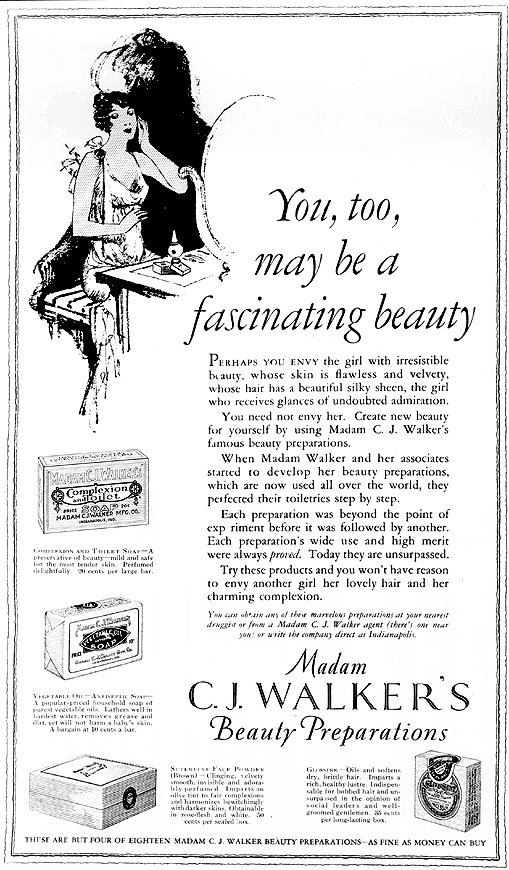
You need not envy her. Create new beauty for yourself by using Madam C. J. Walker's famous beauty preparations.
When Madam Walker and her associates started to develop her beauty preparations, which are now used all over the world, they perfected their toiletries step by step.
Each preparation was beyond the point of experiment before it was followed by another. Each preparation's wide use and higher merit were always proved. Today they are unsurpassed.
Try these products and you won't have reason to envy another girl her lovely hair and her charming complexion.
Complexion and Toilet Soap--A preservative of beauty--mild and safe for the most tender skin. Perfumed delightfully. 20 cents per large bar.
Vegetable Oil--Antiseptic Soap--A popular-priced household soap of purest vegetable oils. Lathers well in hardest water, removes grease and dirt, yet will not harm a lady's skin. A bargain at 10 cents a bar.
Superfine Face Powder (Brown)--Clinging, velvety smooth, invisible and adorably perfumed. Imparts an olive tint to fair complexions and harmonizes bewitchingly with darker skins. Obtainable in rose-flesh and white. 50 cents per sealed box.
Glossine--Oils and softens dry, brittle hair. Imparts a rich, healthy lustre. Indispensable for bobbed hair and unsurpassed in the opinion of social leaders and well-groomed gentlemen. 35 cents per long-lasting box.
Questions for Document 1
1. What products are advertised?
2. What language does the ad use to entice women to purchase the products? Do you think it would have been effective? Why or why not?
Document 1 was provided courtesy of the Indiana Historical Society, Walker Collection.
Determining the Facts
Document 2: Advertisement for the Golden Rule Store, 1908.
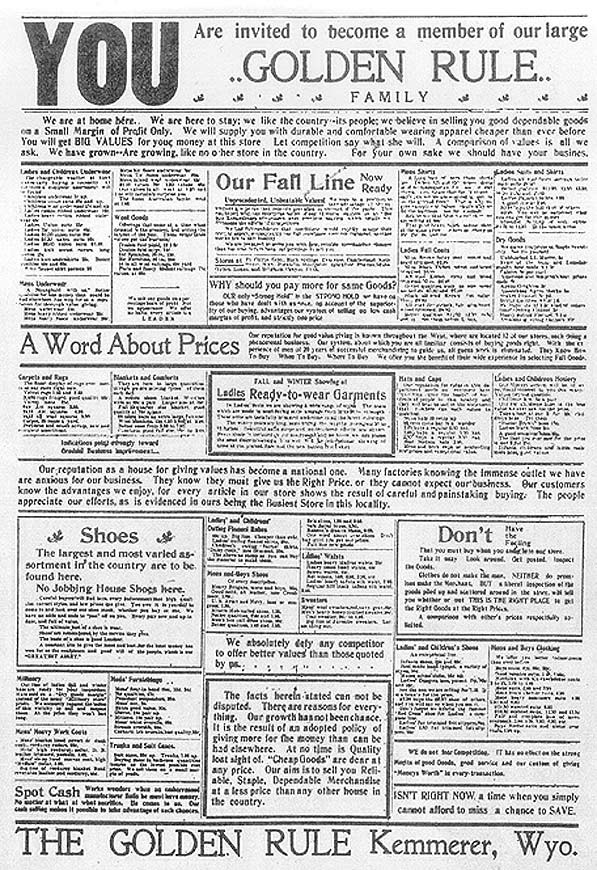
Partial transcript of advertisement
We are at home here. We are here to stay; we like the country—its people; we believe in selling you good dependable goods on a Small Margin of Profit Only. We will supply you with durable and comfortable wearing apparel cheaper than ever before. You will get BIG VALUES for your money at this store. Let competition say what she will. A comparison of values is all we ask. We have grown—Are growing, like no other store in the country. For your own sake we should have your business.
A WORD ABOUT PRICES: Our reputation for good value giving is known throughout the West where are located 12 of our stores, each being a phenomenal business. Our system about which you are familiar consists of buying goods right. With the experience of men of 20 years of successful merchandising to give us, all guess work is eliminated. They Know How to Buy. When to Buy. Where to Buy. We offer you the benefit of their wide experience in selecting Fall Clothes.
Our reputation as a house for giving values has become a national one. Many factories knowing the immense outlet we have are anxious for our business. They know they must give us the Right Price or they cannot expect our business. Our customers know the advantages we enjoy, for every article in our store shows the result of careful and painstaking buying. The people appreciate our efforts as is evidenced in ours being the Busiest Store in this locality.
We absolutely defy any competitor to offer better values than those by quoted by us.
The facts herein stated can not be disputed. There are reasons for everything. Our growth has not been chance. It is the result of an adopted policy of giving more for the money than can be had elsewhere. "Cheap Goods" are dear at any price. Our aim is to sell you Reliable, Staple, Dependable Merchandise at a less price than any other house in the country.
ISN'T RIGHT NOW a time when you simply cannot afford to miss a chance to SAVE.
Questions for Document 2
Study the advertisement and then refer to the partial transcript to answer the following questions.
1. Who did Penney expect to read this ad? What did he mean when he wrote, "You are invited to become a member of our large Golden Rule family." What adjectives can you use to describe this section of the advertisement?
2. What did Penney mean by saying that "cheap goods" are expensive at any price? How did he assure the customer that there were no "cheap goods" at Penney stores?
3. How would you compare Penney's advertisement with contemporary ads?
Document 2 was provided courtesy of the J.C. Penney Archives, Dallas, TX.
Visual Evidence
Drawing 1: Artist's conception of the opening of the first Golden Rule Store in 1902.
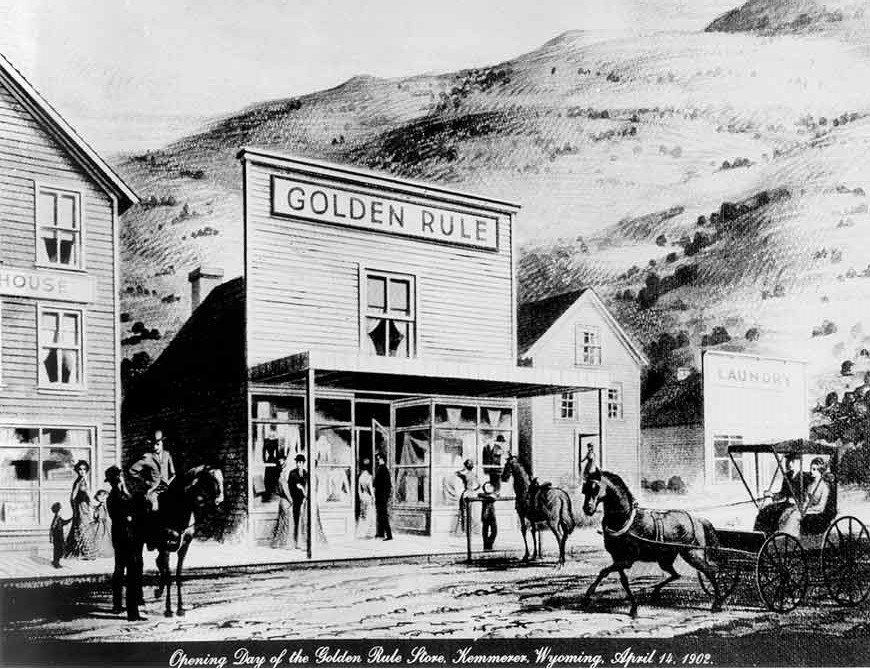
(J.C. Penney Archives)
Photo 1: The Golden Rule Store, 1904.
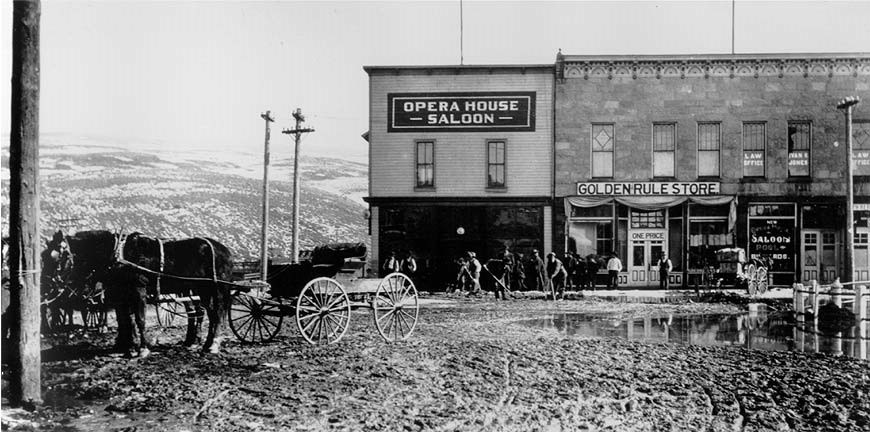
J. C. Penney Archives
By 1904 the Golden Rule Store (no longer standing) had outgrown its one-room frame building off the main business district of the town. On August 1, 1904, Penney moved the store into the left side of the stone building shown in Photo 1. He occupied a 25-by-140 foot section. It became a J.C. Penney store in 1913, and the Penney Company continued to operate a store here until moving to a new location in 1929.
Questions for Drawing 1 and Photo 1
1. Compare and contrast the two images in terms of the appearance of the buildings, the activities of the people, the surrounding landscape, the general look of the street, and the vehicles.
2. Does the artist's conception of the first store seem idealized? If so, how? What do you think he is trying to convey to the viewer?
3. What other uses did the building serve at the time Photo 1 was taken?
4. If there was no date attached to the photo, what clues might help you figure out when it was taken?
Visual Evidence
Photo 2: Madam C.J. Walker Manufacturing Company building.
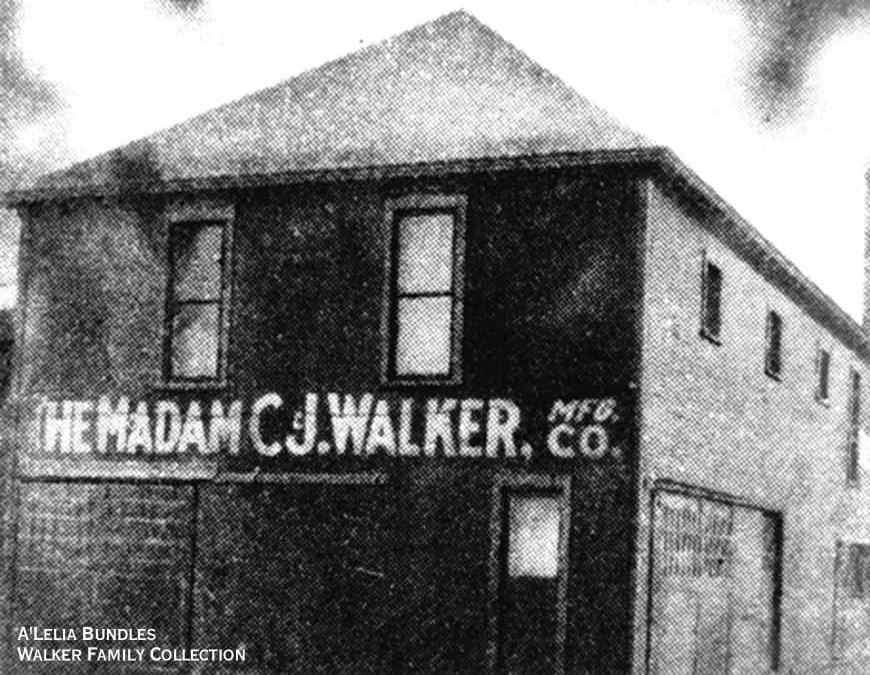
(A'Lelia Bundles/Walker Family Collection)
This is the first building constructed in Indianapolis to house the manufacturing operations of the Madam C.J. Walker Manufacturing Company. Part of the building contained the Indianapolis branch of Lelia College as well as the Madam Walker Beauty Parlor.
Questions for Photo 2
1. How would you describe this building?
2. Why would Madam Walker have needed a large building like this to manufacture her products by 1910?
3. Why would it have been beneficial to house the college and beauty parlor in this building?
Visual Evidence
Photo 3: The Walker Building today.
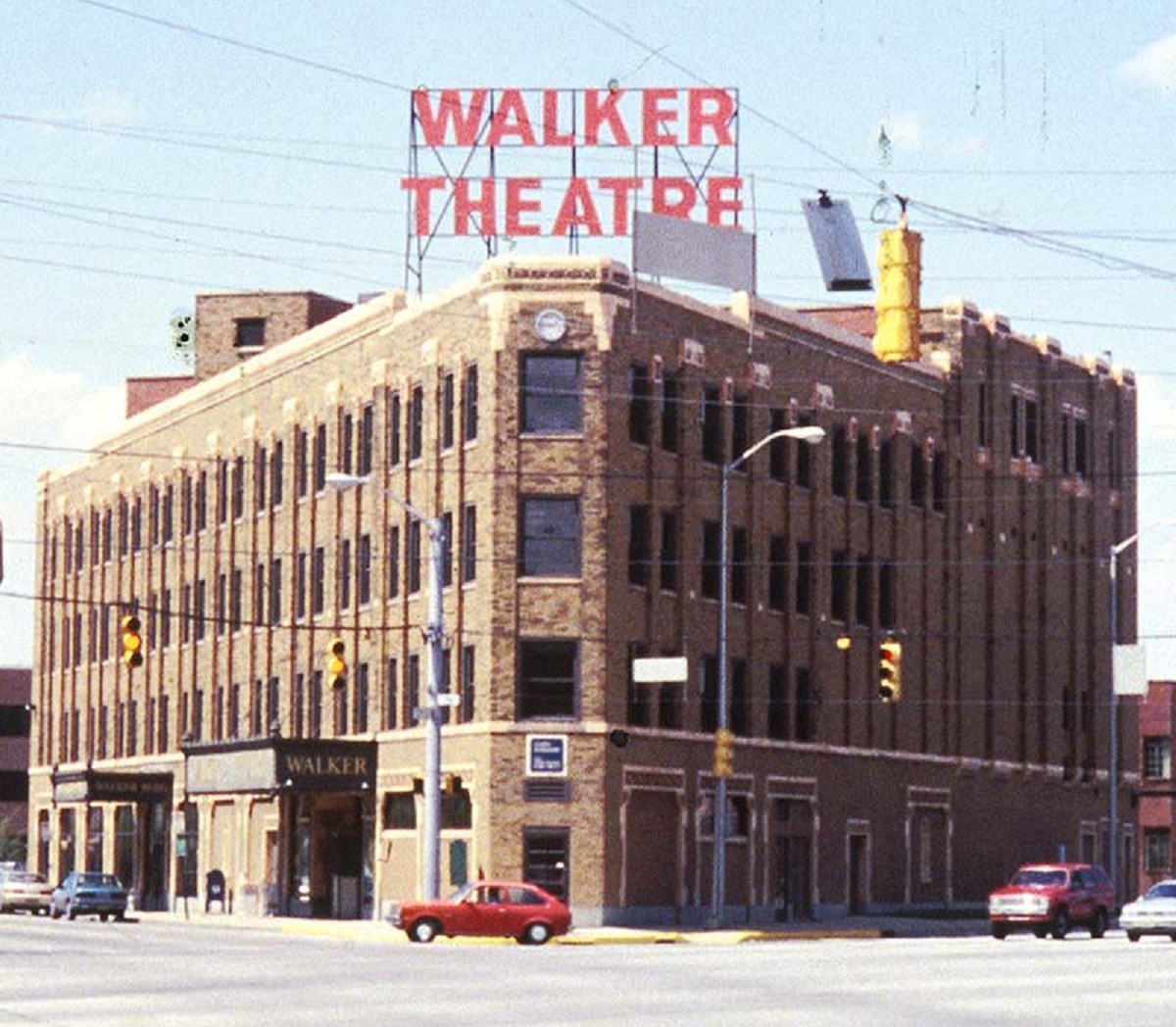
This building was planned by Madam Walker but built by her daughter after her mother's death. In addition to the headquarters of the Madam C. J. Walker Manufacturing Company, the building also housed the Walker Theater, Walker Drug Store, Walker Casino, Walker Beauty Shop, a ballroom, and a coffee shop. African-American doctors, lawyers, and other professionals who had difficulty finding office space in buildings owned by whites rented space in the building as well. The building served as a center for the African-American community. It was restored in the late 1980s. Although the Walker Manufacturing Company is no longer located there, the building continues to house various commercial businesses, including a beauty salon.
Questions for Photo 3
1. How would you describe this building? How does it compare to the building depicted in Photo 2?
2. Why do you think Madam Walker would have wanted to include all these facilities in the building she planned?
3. Why would it have been important to the company to rent office space in the building to African Americans?
Visual Evidence
Photo 4: Madam Walker before and after using the hair preparations she developed.

(A'Lelia Bundles/Walker Family Collection)
Photo 5: Madam Walker, age 42.
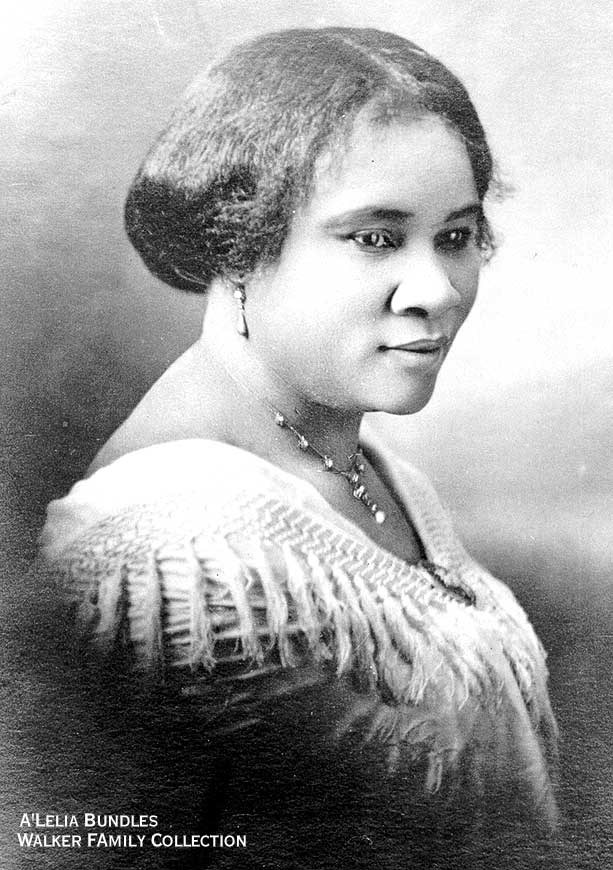
(A'Lelia Bundles/Walker Family Collection)
Questions for Photos 4 and 5
1. Why do you think Madam Walker would have used the portraits shown in Photo 4 in advertisements? Do you think they were effective? Why or why not?
2. How does Photo 5 differ from the images in Photo 4?
Putting It All Together
The following activities will help students understand how hard work, ambition, confidence, a willingness to take risks, knowledge of potential markets, as well as lots of luck, contribute to success in establishing and operating a business.
Activity 1: Comparing Walker and Penney
Have students discuss the careers of Madam C. J. Walker and J. C. Penney, using the following questions as a guide:
l. What personality and character traits do Walker and Penney share?
2. Why do you think both Walker and Penney were successful as business owners? What similarities and differences can you list about how they conducted their enterprises?
3. In what ways did the Walker and Penney businesses benefit society?
4. Is it still possible for individuals to achieve such success? Why or why not? (You might wish to describe the success stories of people like the men who developed Apple computers, William Gates and the Microsoft Corporation, or Sam Walton who founded Wal-Mart stores.)
Activity 2: Changes in Advertising
Students will have noted that advertisements for the Walker products and the Golden Rule Store are quite different from those that are run in newspapers and magazines today. Gather up a collection of fairly recent magazines and newspapers (the students can help) and have students work in groups with at least 10 different kinds of ads. Have them categorize advertisements for beauty products and services and for Penney's or similar stores such as Montgomery Ward. Students can establish their own categories or you might suggest grouping together advertisements with an emphasis on price, quality, style, convenience, or importance to specific ethnic or age groups. Have students also make lists of particular design patterns in ads that they find attractive or compelling. Ask them to compare and contrast the recent advertisements with the Walker or Penney ads. Discuss the findings of each group, and then have each student develop an ad for a product or store to be shown to the class and perhaps displayed on a bulletin board.
Activity 3: Starting a Business
Have students work in groups of four or five to brainstorm ideas for a new business that would be successful in today's society. Have them consider the special needs of different groups of people, the types of products or services that would improve their lives, and the ways in which a new business might be developed in their own community. Have them consider whether they would develop a new product or a new way of merchandising an existing line of related products. After the groups have decided on the type of business they would like to start, have them draw up a list of steps they would have to take to make the business successful. Have each group explain their ideas to the full class. The activity would be enhanced if you could invite a member of the Chamber of Commerce or a similar organization to visit the class and comment on the practicality of the students' ideas.
Activity 4: Researching a Local Business
Have students choose a local business that is very successful or a business that is part of a nationwide chain and conduct research into its founding and operation. Have them first develop a research plan and divide up tasks among class members. Some students can conduct interviews with the owners and workers of the business and with customers. Others can do research on the business in the local history section of their public library. They can use city or county business directories to see how long the business has operated and at what addresses. Stories in old newspapers will probably describe when the business was opened and what changes have been made over the years. Students will probably also be able to find newspaper advertisements placed by the company.
After the research has been conducted and discussed by the class, have them compare the information they have found with the origins of both the Madam C. J. Walker Manufacturing Company and the J. C. Penney Company. Ask them whether any buildings associated with these businesses remain. If so, do they think it would be important to preserve the buildings as part of their community's history, like the Walker building in Indianapolis and the Penney buildings in Kemmerer?
Two American Entrepreneurs--
Supplementary Resources
By looking at Two American Entrepreneurs, students can learn the stories behind the success of two of America's most famous early 20th–century businesspeople. Those interested in learning more will find that the Internet offers a variety of materials.
National Park Service
The National Register of Historic Places' on-line travel itinerary, Places Where Women Made History highlights 74 historic properties in Massachusetts and New York that are associated with the many varied aspects of women's history.
Library of Congress
The Library of Congress's American Memory Web page offers a collection of materials titled, Prosperity and Thrift: The Coolidge Era and the Consumer Economy, 1921-1929. The following links are of particular interest:
-
Chain Stores
Includes a speech delivered to the second annual convention of the National Chain Store Association (1929) by Earl C. Sams, president of the J.C. Penney Company. -
Madam Walker
Provides links to advertismements for the Madam C.J. Walker Manufacturing Company. -
National Negro Business League
Offers information on this organization, which was founded by Booker T. Washington in 1900 "to promote the commercial and financial development of the Negro" and to bring African Americans into the middle-class mainstream.
Madam C.J. Walker
The Madam C.J. Walker Web page, owned and maintained by the great-great-granddaughter and biographer of Madam C.J. Walker, offers a wealth of information on Madam Walker.
Tags
- entrepreneur
- entrepreneurs
- women's history
- women and the economy
- african american history
- african american women
- indiana
- indiana history
- wyoming
- wyoming history
- national register of historic places
- nrhp listing
- teaching with historic places
- twhp
- gilded age
- women leaders
- women in the workplace
- womens work
- economic history
- business history
- early 20th century
- progressive era
- labor history
- labor
- twhplp
- banking
